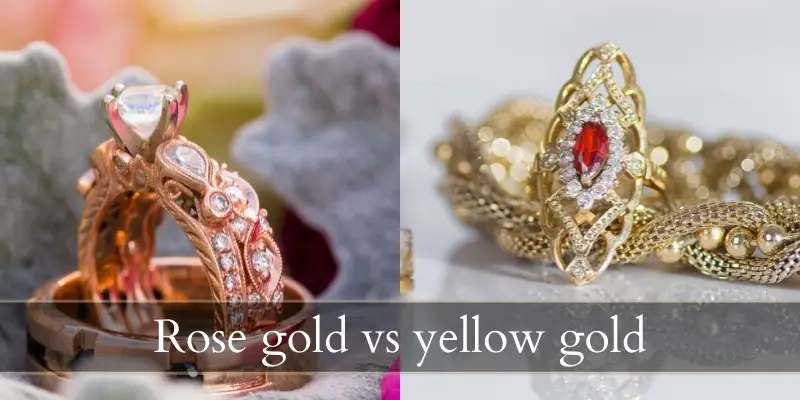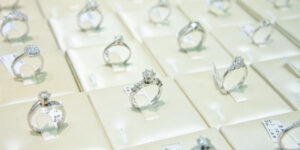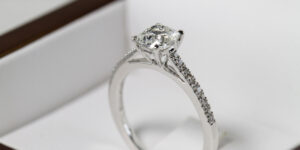Rose and yellow gold are two of the most luxurious-looking gold colors. One is antient and well known, one is more modern and incredibly trendy in the last few years. If you find yourself wondering whether rose gold or yellow gold suit you better, wonder no more.
This post will compare rose gold with yellow gold, look into what they’re actually made of, and help you decide the perfect jewelry metal for you.

Rose gold vs yellow gold
Rose gold is much more durable and scratch-resistant than yellow gold due to its high copper content, yet may leave a green mark on your skin. Yellow gold is the classic color for gold, associated with luxury and prestige while rose gold is a newer color that may confuse some people. Instead rose gold compliments most skin tones while yellow gold pairs much better with warmer skin tones.
Both rose and yellow gold are gold alloys, so they are not 100% gold but instead contain some copper, and silver. This is done to make the gold more durable and to keep it from picking up as many scratches. Let’s explore these differences in more detail.
1. Rose gold is tougher than most yellow gold
Rose gold tends to be tougher than yellow gold of the same karat. This is because rose gold contains much more copper than yellow gold, hence the pinkish color.
All gold on the market is actually a gold alloy. Pure 24k gold is too soft to use on its own, so it much be mixed with another metal to make it more durable. This way it won’t bend out of shape and it won’t scratch as easily. This is done by adding copper and silver into the mix.
For example 18k rose gold has 75% gold, 22.25% copper, and 2.75% silver. Lower karat rose gold (like 14k) has more copper and possibly no silver at all. Copper is a much harder material than gold, so it lends it durability and strength to the alloy.
In the meantime 18k yellow gold is 75% gold, 12.5 % copper, and 12.5% silver. This difference in copper makes yellow gold softer and less durable than rose gold.
Of course, both will last you for several years. But dents and scratches will show up faster on yellow gold, and you may need to get your jewelry polished more often. In the case of very dainty gold pieces, like dangly earrings or very intricate designs, the strength of the metal matter a lot.
Read also: Blue Topaz Engagement Ring Meaning
2. Yellow gold is timeless and luxurious
Yellow gold has been the go-to gold color for millennia. Ever since we discovered how to cast gold and mix it with other metals, we’ve tried to keep gold as yellow and warm as possible. True gold has a deep, almost glowing warm yellow to it, almost like amber. This color has captured the hearts of many royals, so anyone of at least some importance was trying very, very hard to get yellow gold.
And for the longest time gold was an exclusive metal. You couldn’t really get your hands on it, or it on your hands. Gold became a symbol of wealth and power, something many people struggled for.
Rose gold by comparison is much more recent. The old name for rose gold was Russian gold, because this particular alloy was first made famous by none other than Carl Faberge, the one who created the world-famous Faberge eggs in the late 1800s. The fame of these beautiful jeweled eggs mare rose gold internationally famous, to the point where Cartier later picked up the trend and made it famous in America.
Rose gold has fallen in and out of fashion every since, and whenever it makes a comeback it’s always regarded as a chic, feminine, romantic and very trendy version of gold. But, it always fades back into obscurity, only to resurface a couple of decades later.
If you want a piece that will be classic, timeless, and instantly convey the idea of prestige, go for yellow gold. It will always be in style.
3. Rose gold compliments all skin tones
Due to rose gold’s not-pink-not-yellow color it manages to work well with any and all skin tones. Warm, neutral, and cool skin tones find something to work with when they wear rose gold, as there is enough of a color balance in this metal. You could call it a neutral color, in a way.
Yellow gold has a deep warm yellow to it, and it pairs much better with warm skin tones that have a yellow undertone. You can check your skin’s undertone (cool, warm, neutral) by checking the veins on your wrists.
Purple-blue veins ? Dominant cool tone, would go great with silver and white gold.
Greenish veins ? Dominant warm tone, would go great with yellow gold.
An even mix of colors, can’t really tell ? Most likely neutral tone, can go with anything, including rose gold.
Please remember that skin tones and their undertones are a spectrum, not a set of 3 rigid categories. The right color metal will make your skin look lively and youthful, while the wrong color will wash you out.
4. Yellow gold might not turn your skin green
While both yellow and rose gold have some copper in them, rose gold has much more copper. In some cases it’s nearly half, such as 14k rose gold or less. If you sweat a lot or you have a strong copper allergy you have much higher chance of getting that dreaded green ring on your finger, or a green stain on your skin.
It can be washed off, of course, but it’s still something to be aware of. Rose gold may not turn your skin green immediately, but may do so in time. Yellow gold has a lower chance of turning your skin green as it contains much less copper.
Is rose gold cheaper than yellow gold ?
No, rose gold is not cheaper than yellow gold because both have a good amount of gold in them, and that is the only thing a jeweler or pawn shop base their prices on. A 14k rose gold ring will be cheaper than an 18k yellow gold ring only because there is more gold in the 18k gold alloy – 75% gold compared to 55%.
Is rose gold real gold ?
Yes, rose gold is real gold, its color is just different due to the higher amount of copper in the alloy. Yellow gold also has copper in its alloy, but it is less copper because there is more silver in the mix. Where rose gold is usually 1:1 gold to copper, yellow gold is 2:1:1 gold to copper to silver, to get the right color.
Does rose gold tarnish ?
No, rose gold does not tarnish, in the sense that it does not turn black. However it may darken in time, along several decades. Rose gold darkens much faster if not continuously worn. A ring worn every day will keep its rosy color much better than one stowed away.
Silver is the one with black tarnish, and there is a very small amount of silver in rose gold. But this amount is not enough to tarnish the rose gold black. Instead rose gold will slowly change color like copper, meaning it will turn darker and possibly a bit brown. It should not turn blue or green unless kept in very humid places for a very long time.

I’m the main author for jewelrymaterialguide.com. I started this site after we did tons of research before our wedding and noticed that there is information about rings, jewelry, and so on that is really hard to find on the internet.






